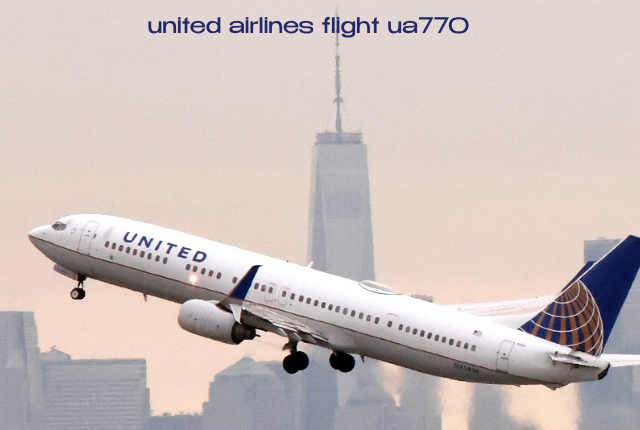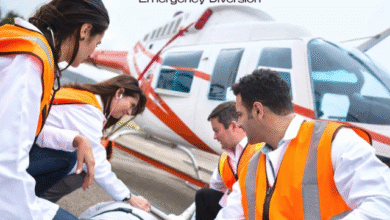United Airlines Flight UA770

In today’s world, where everything related to air travel is done through apps and the entire process is monitored closely, even a slight mishap could cause a great uproar, teach lessons, and provide insight into important matters. One of the incidents which gained a lot of attention was United Airlines flight UA770’s diversion from Dulles airport to San Francisco. The internal tussle that was faced by United Airlines to resolve the issue showed not just the extent of the crisis the airline was dealing with but also the delicate equilibrium that airline practices, customer service expectations, and security protocols maintain.
In this post, we will analyse United Airlines flight UA770 in depth, paying close attention to the reasons for the diversion, the subsequent impact on passengers, the airline’s responses, and the commercial aviation repercussions.
Table of contents
What Is United Airlines Flight UA770?
United Airlines Flight UA770 is scheduled twice a week as part of the United Airlines network, with the company normally using a Boeing 757-300 for this route. Connecting the East Coast business hubs and tourist sites with the West Coast, the flight serves both business and leisure passengers. On July 17, 2025, this flight attracted attention by landing unexpectedly at Denver International Airport (DIA).
According to the passengers on United Airlines flight UA770, they experienced a smooth takeoff from Washington Dulles. However, a few hours later, the airplane started to drift off its expected path and began descending toward Denver. The captain informed the passengers that some technical issues had arisen which required the aircraft’s immediate attention.
Midair Diversion: What Triggered the Change of Course?
While United Airlines’s official statement attributed the flight diversion to “precautionary technical concerns,” internal documents suggested there was a possible hydraulic system problem. Although modern planes are built with several backup systems for safety, experts believe that a failure in the hydraulic systems would limit the control surfaces or brakes—both critical during landing.
In diverting United Airlines Flight 770 to Denver, the crew adhered to stringent FAA regulations that required safely guiding a flight to the nearest airport in cases of certain mechanical problems.
The Flight Timeline: From Departure to Diversion
In order to assist the readers, a step-by-step timeline is provided below chronologically detailing United Airlines flight UA770 on the day of the diversion.
- 10:30 AM EDT: Washington Dulles International Airport (IAD) sent off
- 12:50 PM MDT: Decision to divert mid-air
- 1:30 PM MDT: Arrival at Denver International Airport (DEN)
- 2:15 PM MDT: Passengers provided assistance and deplaned
- 5:00 PM MDT: Boarded alternate flights to San Francisco and departed
All passengers aboard United Airlines flight UA770 were reportedly unharmed. Moreover, the airline crew onboard were said to have acted very professionally thereby receiving commendations.
Voicing Experiences From the Cabin
Passengers took to social media and blogs to portray their experiences of the flight post-diversion. While the sudden shift to Denver was jarring, the vast majority agreed that the cabin crew managed the crisis calmly and methodically.
For United Airlines flight UA770, some passengers were profiled to board the flight due to time-sensitive obligations like going to a wedding or a job interview. United Airlines issued generous meal vouchers, travel credits, and offered to arrange hotels. Though, some passengers lamented how little proactive communication was made online by the airline during the disruption.
Communication Breakdown or Industry Standard?
The incident raises salient issues on how airlines communicate during crises. Passengers travelling on United Airlines flight UA770 reported that announcements were only made after long stretches of time elapsed. While safety measures dominated, the backlog in updates led to frustration for some of the travellers.
To mitigate confusion like what United Airlines flight UA770 passengers experienced, United Airlines now plans to improve real-time communication systems including push notifications, email alerts, and app-based updates.
What Should The Passengers Do if There is a Change in Route?
Here is how people can limit chaos based off of the United Airlines flight UA770 incident:
- Have in your possession at all times a basic medical kit which contains essential toiletries alongside medicine, chargers, snacks and more.
- Snacks and conducts alongside medicine which many airlines fail to provide also ensure that airline conductors grab these things at all times.
- Planes are often equipped with television screens enabling people to keep tabs of updated flights via FlightAware or United’s mobile app free of charge.
- U.S. based airlines have a legal mandate to provide rerouting scheduling and basic level service for extended waits.
- It is vital to remember that while diversions are troublesome, they are necessary for your safety.
Based on the tips provided above passengers on United Airlines flight UA770 were able to rebook stress-free and quickly.
Legal and Policy Implications
According to the Department of Transportation (DOT), airlines are not required to pay for delays due to safety issues. As a matter of policy, however, airlines do routinely provide some form of payment, whether in the form of loyalty programme credits, free tickets, or travel vouchers.
After the case of United Airlines flight UA770, consumer advocacy groups have expressed the need for stronger policies outlining what passengers are entitled to in case of a diversion.
United Airlines’ Internal Review
Sources say that United Airlines did conduct an internal review triggered by the UA770 diversion. The review included:
- Inspecting maintenance logs
- Audit of emergency response drills
- Evaluating internal chain communications
While the core problem was mechanical, aviation experts have said that the ground and cabin crew’s response was “industry standard” blind compliance to protocols.
Industry Experts Analyse the UA770 Incident
Experts in the field noted that United Airlines flight UA770 was a textbook case in mitigating risks at every level. Flight crews executed safety procedures, communicated with air traffic control, provided first aid, and took strides towards ensuring the comfort and safety of passengers through the entire process.
Authorities were also discussing how the use of some predictive maintenance tools might have flagged the problem preemptively and solved the issue prior to departure. Many airlines are starting to adopt the use of AI and IoT in an effort to prevent incidents like United Airlines flight UA770.
Financial Consequences and Changes in Operations
Disruptions such as United Airlines Flight UA770 have a huge financial impact. Airlines not only pay passenger compensation, but they also have to pay rerouting fees, airport usage cost, and deal with incurred public relations damage. For United Airlines, they absorbed most of the expenses internally and maintained a steady flow in operations, facing only minimal long-term disruption.
In the wake of the incident, these operational steps were taken:
- Crew training improvements
- Enhanced software monitoring upgrades onboard
- Upgraded hydraulic system software
These UA770 specific measures have been taken in effort to mitigate the chances of such scenarios happening in the future.
Recent High-Profile Diversions
Flight UA770 is not the only flight diversion that has attracted significant attention.
- Delta DL202 Smoke in the Cabin Diversion (2023)
- American Airlines Flight AA139: Fuel System Warning Emergency Landing (2024)
The primary distinguishing factor with UA 770 is the level of engagement passengers had online and the visibility of follow-through action transparency.
Coverage Analysis and Reaction
Aviation blogs and news outlets including CNN and Bloomberg provided extensive coverage for the incident, UA Flight 770. Initially speculative coverage would later praise the crew’s performance while scrutinising their communication to passengers on the ground.
As a whole, public response was neutral to positive. The majority accepted that, at times, mechanical malfunctions do occur, and in this case, United Airlines provided a commendable response.
Travel Insurance: A Lifeline After Diversions
Travellers with insurance could claim meal, hotel, and connection reimbursement costs. Policies covering “trip interruption” or “emergency landings” usually apply to cases like United Airlines flight UA770.
Insurance policies should always include these features:
- Delay coverage
- Medical evacuation
- Trip cancellation
This is particularly helpful in the unlikely case that another UA770-like United Airlines disruption occurs.
Passenger Loyalty Programmes and Prioritised Customer Service
Organised MileagePlus members could report accelerated customer service and better access to rerouting. Elite tier members received automatic rebooking and lounge access.
As a frequent flyer, you should consider getting these types of benefits to avoid issues like United Airlines flight UA770.
Psychological Effects of In-Flight Changes
Disruptions can be taxing, especially for those dealing with anxiety and past traumas. After United Airlines flight UA770, mental health advocates demonstrated the importance of:
- Mindfulness in-flight
- Emotional support crew training
- Good post-flight counselling
Although the industry has not adopted these measures, the growing focus on wellness could change that.
Conclusion
The case of United Airlines Flight UA770 highlights the fact that, regardless of technological advancements and stringent safety measures, there are challenges that the aviation industry may encounter. For travellers, it is critical to be aware of the occurrence of changes and reactive measures in how the airline responds to such events. United Airlines Flight UA770’s diversion marked the beginning of a well-orchestrated, albeit somewhat chaotic response from the crew and airline communication. The post-event analysis of the rebooking procedures demonstrated effective management during the crisis.
Comprehending the timeline as well as the formal accounts surrounding United Airlines Flight UA770 allows for a better understanding of one’s travel experience and helps in giving the necessary preparation to assist with potential disruptions. This also helps the traveller appreciate the need and benefits of being informed of their entitlements when the flight they are booked onto is rescheduled, rerouted, or cancelled.
For analysts looking at airline performance indicators or safety changes, United Airlines Flight UA770 offers important lessons about strategic operational decisions and safety standards compliance regarding passenger safety. Be it a frequent traveller or a casual follower of aviation news, paying attention to cases like United Airlines Flight UA770 serves to better prepare them on how to navigate travel disruptions, and equips them with knowledge that can empower their travel decisions.
FAQS
1. What caused the emergency diversion of United Airlines Flight UA770?
United Airlines Flight UA770 was diverted midair due to precautionary technical concerns, reportedly linked to a potential hydraulic system issue. While the official statement emphasized safety protocols, internal sources highlighted that the diversion was a necessary measure to ensure full control of the aircraft’s landing system.
2. How did United Airlines support passengers after Flight UA770 was diverted?
After the diversion of United Airlines Flight UA770 to Denver, passengers were promptly assisted with rebooking, meal vouchers, and travel credits. Though some voiced concerns over limited communication, the crew’s professionalism and United’s eventual response were largely commended for meeting industry standards.
3. What can travelers learn from the United Airlines Flight UA770 incident?
The incident with United Airlines Flight UA770 highlights the importance of being prepared for in-flight disruptions. It reinforces the need for travel insurance, real-time app alerts, and understanding passenger rights. The event also underscores how airlines are evolving to improve transparency and operational safety.





